by: Melinda Cohan
 Every start up coach or service-based practitioner must go through the same five steps to reach the point where she or he is running a thriving business.
Every start up coach or service-based practitioner must go through the same five steps to reach the point where she or he is running a thriving business.
These steps reflect the 50,000-foot perspective: what your entire journey looks like.
Each of them is a building block on your journey to running a thriving business. So you also can’t “half-ass” them. You can’t ignore them. And you can’t skip any of them! Skipping them to reach the destination more quickly doesn’t equal success. In fact, if you do skip ahead, I can pretty much guarantee that you’ll have to go back and revisit the earlier stages.
A quick note: you know you’re off-roading if you haven’t yet created consistent results from the beginning stages and are already incorporating intermediate or advanced strategies. That is what ultimately creates overwhelm!
Because we love you, and because we love making things easy breezy for you, we’ve put the content we’re covering today into an awesome, beautiful, downloadable chart you can get for free, below.
It’s our hope that by reading the rest of this post, answering the questions at the end, and studying the chart, you’ll be able to see where you are now on a clearly defined path to success, and the journey to where you want to be. This is a visual representation of the idea that you’re moving through a process.
Side benefit: your world will feel less overwhelming or chaotic, because you won’t be spreading yourself too thin, trying to accomplish too much from too many stages, all at the same time. This approach takes enlightened discipline and a diligent commitment to yourself and your dreams (and it’s so worth it!).
So go ahead! Download your chart here, and then come back and keep reading (we’ll wait for you):
Where Are YOU On The Success Path? <<< Download Your Chart Now
Now, let’s get to the nitty gritty!
First, we’ll describe The Success Path and each of its Five Stages, and then we’ll give you an exercise to help you determine where you are now on the path, so that you know what to do to continue moving toward your dream business as quickly as possible.
The Success Path
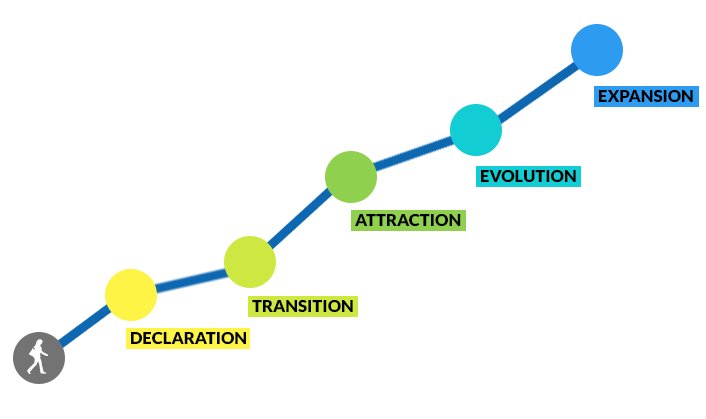
As a new business owner, it’s helpful to see the path you’re taking to build your biz. Think about when you use your smartphone to map out your route to a particular destination. You enter your current location, and then your desired destination. Then, your mapping app calculates your route, and shows it to you.
Clear. Easy breezy. Right?
Why is it then, that many startup coaches or practitioners blindly pursue their passions without knowing, in advance, the route they’re going to follow, or the path that lies ahead?
When they do, they end up feeling lost and scattered, unsure of how far they’ve traveled, or how far they have left to go.
The Success Path solves that problem by showing startup coaches and practitioners the route they’ll be taking.
Let’s go over each of the Stages of The Success Path now, and then look at how they relate to the learning process.
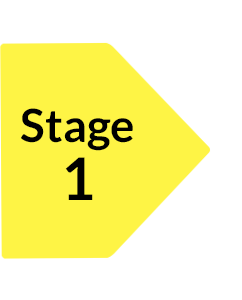 Declaration Stage
Declaration Stage
Goal: To make the deep, soul-level commitment to do whatever it takes to create the success of which you dream, even if, at this time, it seems counter-intuitive or counter-logical.
Focus: Gather what’s necessary to make the move from full-time job to full-time business.
Blind Spot: Not creating a financial cushion to bridge the gap from J-O-B to business results. Your cushion should cover three to five months’ worth of essential, fixed costs necessary for survival. This way, you can proceed on the Success Path without that horrible feeling of desperation to make money immediately, like RIGHT NOW. If you can’t set aside the cushion in advance, consider getting a “bridge job”—a part- or full-time, low-stress gig—to help with these expenses as you get clear in your commitment, vision, and goals.
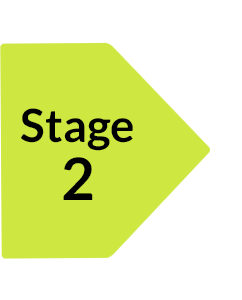 Transition Stage
Transition Stage
Goal: To build your list.
Focus: Create the components to identify, find, attract, and engage prospects, and implement the funnels, strategies, and best practices to grow your list.
Blind Spot: Pursuing your business—specifically, trying to go out and get clients—without knowing, in advance, all the pieces and best practices you’ll need in it, which results they drive, and why they’re important; for example, what it takes to find, engage, and convert prospects into clients (Stage 2 is where a coach should focus on collecting names and building a list). Knowing these things brings order to the otherwise chaotic, overwhelming task of running a business. Take time, up front, to know what needs to happen, when. Otherwise, everything feels urgent, and you feel pressured and fearful.
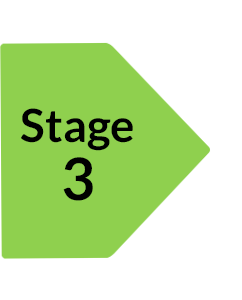 Attraction Stage
Attraction Stage
Goal: To get paying clients.
Focus: Create and implement the tools, resources, and materials necessary to enroll and onboard new clients.
Blind Spot: Neglecting to prepare for enrollment conversations. Here, “prepared” means having your client agreement and onboarding process in place BEFORE you show up for the enrollment conversation, so you’re able to leverage the “yes” when someone decides to work with you. If you don’t have these things ready to go, a new client may have to wait hours or even days until they’re officially onboarded. That means you risk creating a time gap that allows their gremlins creep in, causing them to get cold feet. On the other hand, when your client agreement, autoresponders, and client portal are in place, everything is seamless, and your new client experiences immediate engagement … and you can leverage his or her, “yes.”
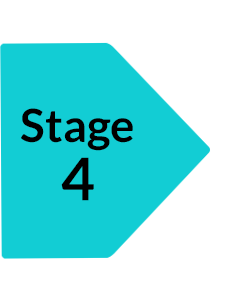 Evolution Stage
Evolution Stage
Goal: To leverage and grow your business.
Focus: Create and implement the tools, resources, and materials necessary to bring automation to your business, add additional revenue streams, and work fewer hours while working with more clients and earning more money.
Blind Spot: Not getting help and support. As you begin to leverage your time, you need to bring on support in implementing and orchestrating everything in your business, including groups, programs, and events. This support comes in the form of team members: a certified VA, a bookkeeper, and so on. If you want to continue to grow, you can’t do it alone. There simply aren’t enough hours in the day.
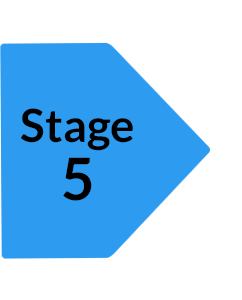 Expansion Stage
Expansion Stage
Goal: To scale your business.
Focus: Build your team, expand into new markets, and work minimal hours, while making more money and a broader impact.
Blind Spot: Attempting to do things in the same way you always have. What got you here won’t get you there. This stage requires you to evolve your internal systems and processes in order to manage the new ways you work with clients, and run your business and team.
Now, let’s look at how these stages relate to the learning process.
The Four Quadrants of Learning
We want to share with you the four Quadrants of Learning; in other words, the process you go through from the moment you launch your business to the moment when you’ve mastered it!
This is important to know because as you move yourself through The Success Path, you’ll go through a learning process—an evolution as a coach-preneur. In addition to knowing how to move along The Success Path, we want you to understand that learning process and evolution, because it will require you to step out of your comfort zone and into the next greatest version of yourself (and as you know, “out of your comfort zone” can feel uncomfortable … which is why we wanted to give you a heads up about what to expect).
These quadrants represent the emotional, behavioral and energetic journey you’ll experience as you move through the stages of The Success path.
Quadrant 1: Unconscious Incompetence. You don’t know what you don’t know, right? You’re just going through your day, nice and easy. Ignorance is bliss!
Quadrant 2: Conscious Incompetence. You encounter something (an experience, a desire, a dream) that sets you on a new path. You now know what you didn’t know before, but you aren’t sure what to do about it. This is where overwhelm begins.
Quadrant 3: Conscious Competence. This is where you bring understanding and order to the chaos. Because you’re still learning new concepts or strategies, mastery requires discipline and effort. With concentrated focus, you get the results for which you’re working. Things can be uncomfortable here. Most that are not cut out for the journey of starting and running a business often retreat back to their comfort zones here. In this stage this is where you become profoundly comfortable with the discomfort of being an entrepreneur. As we mentioned earlier, growth as a coach-preneur will constantly require you to step out of your comfort zone—and that’s actually a great thing as you step into better and better versions of yourself. So it’s time to get comfortable with being uncomfortable (we say this with love!).
Quadrant 4: Unconscious Competence: Habits are formed! What was once confusing or overwhelming is now second nature.
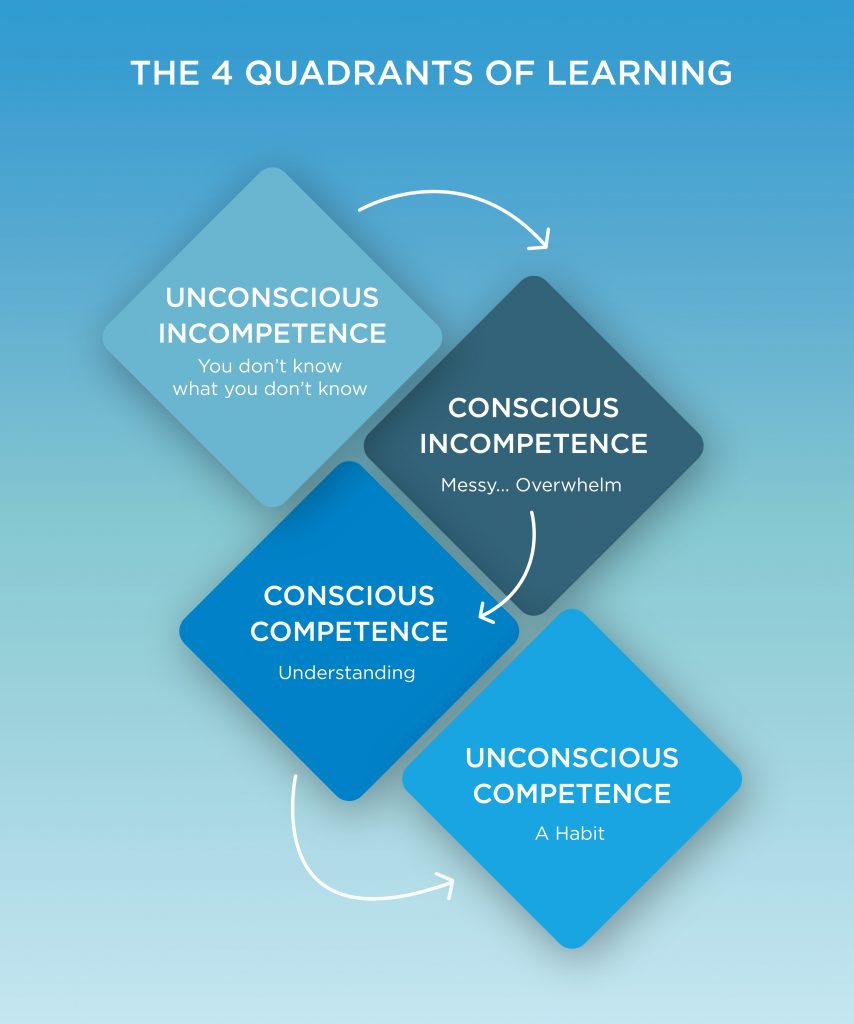
How It All Ties Together
When an entrepreneur first starts down The Success Path, her commitment to starting a business, pursuing her passion, and going for her dreams catapults her out of Quadrant 1 and into Quadrant 2. As she gets guidance and support, she sorts through Quadrant 2 and finds herself in Quadrant 3. And as she continues on The Success Path with continued guidance, support, and accountability (and connected to community), and moves forward toward her dreams and goals, she turns her new actions into habits, moving into Quadrant 4.
The Exercise: Where Are YOU on The Success Path?
Choose one answer – yes or no – to each of the following questions.
1. Are you still in a full-time job?
2. Do you have cash reserves set aside?
3. Have you created your WHY statement?
4. Are your contacts organized into one place?
5. Are you clear in describing your ideal client’s urgent challenges and desired results?
6. Do you have a free gift and lead generation system in place, that consistently grows your list each month?
7. Are you using a New Client Agreement as part of your enrollment conversations?
8. Is your onboarding process in place and automated?
9. Is it easy for you to get paid and track your finances?
10. Do you offer group coaching programs, teleclasses, mastermind groups, etc.?
11. Do you have a team?
Scoring
If you’ve left your existing job and/or have confidently answered yes, with confidence, to questions two and three, you have completed this stage and are ready for the Transition Stage.
Questions four, five, and six relate to the transition stage. If you answered yes, with confidence, you’ve completed this stage and are ready for the Attraction Stage.
Questions seven, eight, and nine relate to the Attraction stage. If you answered yes, with confidence, you’ve completed this stage and are ready for the Evolution Stage, if you want to keep growing.
Questions ten and eleven relate to the Evolution stage. If you answered yes, with confidence, you’ve completed Evolution and are ready for Expansion!
Whew! That is a lot of information, right?
We know it’s a lot to take in, and that’s why this is the first post in a series of posts about The Success Path.
Next, we’ll take a deep dive into each Stage (Declaration, Transition, Attraction, Evolution, and Expansion), so you can learn more about where you are now and what you need to do to move toward Expansion!
This information will be most valuable if you know where you are on The Success Path, so be sure to complete the exercise above before we move on! And meanwhile, don’t forget to download your The Success Path graphic, here, if you haven’t already:
Locate Your Stage, Visualize Your Path <<< Get Your Graphic
